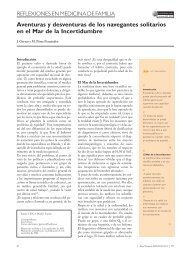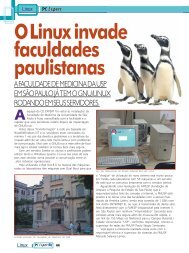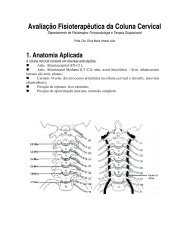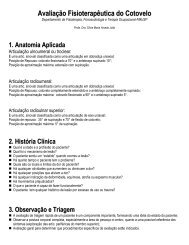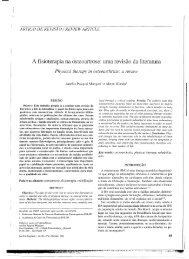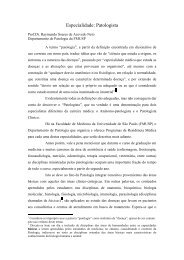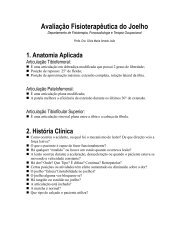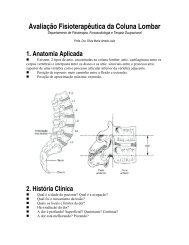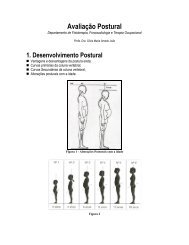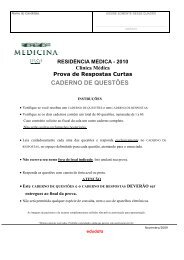American Medical Education 100 Years after the Flexner Report
American Medical Education 100 Years after the Flexner Report
American Medical Education 100 Years after the Flexner Report
Create successful ePaper yourself
Turn your PDF publications into a flip-book with our unique Google optimized e-Paper software.
The new england journal of medicine<br />
review Article<br />
<strong>Medical</strong> <strong>Education</strong><br />
Malcolm Cox, M.D., and David M. Irby, Ph.D., Editors<br />
<strong>American</strong> <strong>Medical</strong> <strong>Education</strong> <strong>100</strong> <strong>Years</strong><br />
<strong>after</strong> <strong>the</strong> <strong>Flexner</strong> <strong>Report</strong><br />
Molly Cooke, M.D., David M. Irby, Ph.D., William Sullivan, Ph.D.,<br />
and Kenneth M. Ludmerer, M.D.<br />
<strong>Medical</strong> education seems to be in a perpetual state of unrest.<br />
From <strong>the</strong> early 1900s to <strong>the</strong> present, more than a score of reports from<br />
foundations, educational bodies, and professional task forces have criticized<br />
medical education for emphasizing scientific knowledge over biologic understanding,<br />
clinical reasoning, practical skill, and <strong>the</strong> development of character, compassion,<br />
and integrity. 1-4 How did this situation arise, and what can be done about<br />
it? In this article, which introduces a new series on medical education in <strong>the</strong> Journal,<br />
we summarize <strong>the</strong> changes in medical education over <strong>the</strong> past century and describe<br />
<strong>the</strong> current challenges, using as a framework <strong>the</strong> key goals of professional education:<br />
to transmit knowledge, to impart skills, and to inculcate <strong>the</strong> values of <strong>the</strong><br />
profession.<br />
Abraham <strong>Flexner</strong> and <strong>American</strong> <strong>Medical</strong> <strong>Education</strong><br />
Almost a century ago, Abraham <strong>Flexner</strong>, a research scholar at <strong>the</strong> Carnegie Foundation<br />
for <strong>the</strong> Advancement of Teaching, undertook an assessment of medical education<br />
in North America, visiting all 155 medical schools <strong>the</strong>n in operation in <strong>the</strong><br />
United States and Canada. His 1910 report, addressed primarily to <strong>the</strong> public,<br />
helped change <strong>the</strong> face of <strong>American</strong> medical education. 5-7 The power of <strong>Flexner</strong>’s<br />
report derived from his emphasis on <strong>the</strong> scientific basis of medical practice, <strong>the</strong><br />
comprehensive nature of his survey, and <strong>the</strong> appeal of his message to <strong>the</strong> <strong>American</strong><br />
public. Although reform in medical education was already under way, <strong>Flexner</strong>’s report<br />
fueled change by criticizing <strong>the</strong> mediocre quality and profit motive of many<br />
schools and teachers, <strong>the</strong> inadequate curricula and facilities at a number of schools,<br />
and <strong>the</strong> nonscientific approach to preparation for <strong>the</strong> profession, which contrasted<br />
with <strong>the</strong> university-based system of medical education in Germany.<br />
At <strong>the</strong> core of <strong>Flexner</strong>’s view was <strong>the</strong> notion that formal analytic reasoning, <strong>the</strong><br />
kind of thinking integral to <strong>the</strong> natural sciences, should hold pride of place in <strong>the</strong><br />
intellectual training of physicians. This idea was pioneered at Harvard University,<br />
<strong>the</strong> University of Michigan, and <strong>the</strong> University of Pennsylvania in <strong>the</strong> 1880s but<br />
was most fully expressed in <strong>the</strong> educational program at Johns Hopkins University,<br />
which <strong>Flexner</strong> regarded as <strong>the</strong> ideal for medical education. 8 In addition to a scientific<br />
foundation for medical education, <strong>Flexner</strong> envisioned a clinical phase of education<br />
in academically oriented hospitals, where thoughtful clinicians would pursue<br />
research stimulated by <strong>the</strong> questions that arose in <strong>the</strong> course of patient care and<br />
teach <strong>the</strong>ir students to do <strong>the</strong> same. To <strong>Flexner</strong>, research was not an end in its own<br />
From <strong>the</strong> Department of Medicine, University<br />
of California, San Francisco, San<br />
Francisco (M.C., D.M.I.); <strong>the</strong> Carnegie<br />
Foundation for <strong>the</strong> Advancement of<br />
Teaching, Stanford, CA (M.C., D.M.I., W.S.);<br />
and <strong>the</strong> Department of Medicine, Washington<br />
University, St. Louis (K.M.L.).<br />
N Engl J Med 2006;355:1339-44.<br />
Copyright © 2006 Massachusetts <strong>Medical</strong> Society.<br />
n engl j med 355;13 www.nejm.org september 28, 2006 1339<br />
Downloaded from www.nejm.org by JOAQUIM E. VIEIRA on November 24, 2006 .<br />
Copyright © 2006 Massachusetts <strong>Medical</strong> Society. All rights reserved.
1340<br />
Courtesy of <strong>the</strong> Carnegie Corporation of New York.<br />
Abraham <strong>Flexner</strong>.<br />
right; it was important because it led to better<br />
patient care and teaching. Indeed, he subscribed<br />
to <strong>the</strong> motto, “Think much; publish little.” 9<br />
Transformation of Medicine<br />
in <strong>the</strong> 20th Century<br />
The academic environment has been transformed<br />
since <strong>Flexner</strong>’s day. In academic hospitals, research<br />
quickly outstripped teaching in importance, and<br />
a “publish or perish” culture emerged in <strong>American</strong><br />
universities and medical schools. Research productivity<br />
became <strong>the</strong> metric by which faculty accomplishment<br />
was judged; teaching, caring for patients,<br />
and addressing broader public health issues were<br />
viewed as less important activities. Thus, today’s<br />
subordination of teaching to research, as well as<br />
<strong>the</strong> narrow gaze of <strong>American</strong> medical education<br />
on biologic matters, represents a long-standing<br />
tradition. 8<br />
In addition to <strong>the</strong> shift in <strong>the</strong> importance of<br />
research relative to teaching and patient care, a<br />
transformation in <strong>the</strong> process of research on human<br />
disease has contributed to our current state<br />
of affairs. For <strong>the</strong> first half of <strong>the</strong> 20th century,<br />
a distinctive feature of <strong>American</strong> medical edu-<br />
The new england journal of medicine<br />
n engl j med 355;13 www.nejm.org september 28, 2006<br />
cation was <strong>the</strong> integration of investigation with<br />
teaching and patient care. Teaching, clinical care,<br />
and investigation each served <strong>the</strong> o<strong>the</strong>rs’ purposes,<br />
because most research was based on <strong>the</strong> direct<br />
examination of patients. Gifted clinical investigators<br />
tended to be equally gifted as clinicians and<br />
clinical teachers. After 1960, however, as medical<br />
research became increasingly molecular in orientation,<br />
patients were bypassed in most cuttingedge<br />
investigations, and immersion in <strong>the</strong> laboratory<br />
became necessary for <strong>the</strong> most prestigious<br />
scientific projects. Clinical teachers found it increasingly<br />
difficult to be first-tier researchers, and<br />
fewer and fewer investigators could bring <strong>the</strong><br />
depth of clinical knowledge and experience to<br />
teaching that <strong>the</strong>y once had. 10<br />
The increasing turbulence of <strong>the</strong> health care<br />
environment in <strong>the</strong> past 20 years has generated<br />
a second set of conditions inimical to medical<br />
education as <strong>Flexner</strong> imagined it. Clinical teachers<br />
have been under intensifying pressure to increase<br />
<strong>the</strong>ir clinical productivity — that is, to<br />
generate revenues by providing care for paying<br />
patients. 11-13 As a result, <strong>the</strong>y have less time available<br />
for teaching, often to <strong>the</strong>ir immense frustration.<br />
In addition, <strong>the</strong> harsh, commercial atmosphere<br />
of <strong>the</strong> marketplace has permeated many<br />
academic medical centers. Students hear institutional<br />
leaders speaking more about “throughput,”<br />
“capture of market share,” “units of service,” and<br />
<strong>the</strong> financial “bottom line” than about <strong>the</strong> prevention<br />
and relief of suffering. Students learn from<br />
this culture that health care as a business may<br />
threaten medicine as a calling.<br />
Thus we arrive at our current predicament:<br />
medical students and residents are often taught<br />
clinical medicine ei<strong>the</strong>r by faculty who spend very<br />
limited time seeing patients and honing <strong>the</strong>ir clinical<br />
skills (and who regard <strong>the</strong> practice of medicine<br />
as a secondary activity in <strong>the</strong>ir careers) or by teachers<br />
who have little familiarity with modern biomedical<br />
science (and who see few, if any, academic<br />
rewards in leaving <strong>the</strong>ir busy practices to teach). In<br />
ei<strong>the</strong>r case, many clinical teachers no longer exemplify<br />
<strong>Flexner</strong>’s model of <strong>the</strong> clinician-investigator.<br />
Learning Medicine as<br />
Professional <strong>Education</strong><br />
All forms of professional education share <strong>the</strong> goal<br />
of readying students for accomplished and respon-<br />
Downloaded from www.nejm.org by JOAQUIM E. VIEIRA on November 24, 2006 .<br />
Copyright © 2006 Massachusetts <strong>Medical</strong> Society. All rights reserved.
sible practice in service to o<strong>the</strong>rs. Thus, professionals<br />
in training must master both abundant<br />
<strong>the</strong>ory and large bodies of knowledge; <strong>the</strong> final<br />
test of <strong>the</strong>ir efforts, however, will be not what <strong>the</strong>y<br />
know but what <strong>the</strong>y do. The purpose of medical<br />
education is to transmit <strong>the</strong> knowledge, impart<br />
<strong>the</strong> skills, and inculcate <strong>the</strong> values of <strong>the</strong> profession<br />
in an appropriately balanced and integrated<br />
manner. 14,15 In <strong>the</strong> apprenticeship model of medical<br />
training that prevailed into <strong>the</strong> mid-19th century,<br />
student physicians encountered this knowledge<br />
and <strong>the</strong>se skills and values as enacted by<br />
<strong>the</strong>ir teachers in <strong>the</strong> course of caring for patients.<br />
How are knowledge, skills, and professional values<br />
represented in contemporary medical education?<br />
The way in which students encounter <strong>the</strong> knowledge<br />
base of medicine has been profoundly influenced,<br />
as <strong>Flexner</strong> intended, by <strong>the</strong> assimilation<br />
of medical education into <strong>the</strong> culture of <strong>the</strong> university.<br />
Theoretical, scientific knowledge formulated<br />
in context-free and value-neutral terms is<br />
seen as <strong>the</strong> primary basis for medical knowledge<br />
and reasoning. This knowledge is grounded in<br />
<strong>the</strong> basic sciences; <strong>the</strong> academy accommodates<br />
less comfortably <strong>the</strong> practical skills and distinct<br />
moral orientation required for successful practice<br />
in medicine. However, <strong>Flexner</strong> had not intended<br />
that such knowledge should be <strong>the</strong> sole or even<br />
<strong>the</strong> predominant basis for clinical decision making.<br />
5 Within 15 years <strong>after</strong> issuing his report,<br />
<strong>Flexner</strong> had come to believe that <strong>the</strong> medical curriculum<br />
overweighted <strong>the</strong> scientific aspects of<br />
medicine to <strong>the</strong> exclusion of <strong>the</strong> social and humanistic<br />
aspects. He wrote in 1925, “Scientific<br />
medicine in America — young, vigorous and<br />
positivistic — is today sadly deficient in cultural<br />
and philosophic background.” 16 He undoubtedly<br />
would be disappointed to see <strong>the</strong> extent to which<br />
this critique still holds true.<br />
Responsibility for <strong>the</strong> care of patients is a powerful<br />
stimulus for learning, 17 and active learning<br />
requires that clinical skills, both cognitive and<br />
procedural, be attained through <strong>the</strong> supervised<br />
provision of patient care. As <strong>Flexner</strong> recognized,<br />
medical novices require <strong>the</strong> opportunity to practice<br />
skills under <strong>the</strong> guidance of experienced teaching<br />
physicians until <strong>the</strong>y attain a high level of<br />
proficiency. Increasing attention to <strong>the</strong> quality of<br />
care, patient safety, and documentation of care<br />
enhances medical practice 18 but threatens to relegate<br />
trainees to <strong>the</strong> role of passive observer. Given<br />
medical education<br />
that every patient deserves <strong>the</strong> best possible care,<br />
we are challenged to provide appropriate opportunities<br />
for experiential learning and practice<br />
while meeting <strong>the</strong> service demands of teaching<br />
hospitals. The educational mission of teaching hospitals<br />
is fur<strong>the</strong>r compromised by <strong>the</strong> absence of<br />
performance standards and assessment methods<br />
that can clearly establish that learners are ready<br />
to advance to <strong>the</strong> next level of independence and<br />
challenge.<br />
The moral dimension of medical education requires<br />
that students and residents acquire a crucial<br />
set of professional values and qualities, at <strong>the</strong><br />
heart of which is <strong>the</strong> willingness to put <strong>the</strong> needs<br />
of <strong>the</strong> patient first. A generation ago, <strong>the</strong> hours<br />
worked served as a simple proxy for dedication to<br />
patients; now, an appropriate concern for <strong>the</strong> wellbeing<br />
of trainees and <strong>the</strong> safety of <strong>the</strong>ir patients<br />
demands a new understanding of what it means<br />
to be dedicated to one’s patients. 19 Professional<br />
values are continuously exemplified and enacted<br />
in <strong>the</strong> course of medical education through role<br />
modeling, setting expectations, telling stories and<br />
parables, and interacting with <strong>the</strong> health care<br />
environment, not just in courses on ethics and<br />
patient–doctor communication. However, <strong>the</strong> values<br />
of <strong>the</strong> profession are becoming increasingly<br />
difficult for learners to discern; <strong>the</strong> conclusions<br />
<strong>the</strong>y draw, as <strong>the</strong>y witness <strong>the</strong> struggle of underinsured<br />
working people to obtain health care,<br />
marked differences in <strong>the</strong> use of expensive technologies<br />
in different health care environments,<br />
and <strong>the</strong>ir physician-teachers in complicated relationships<br />
with companies that make health care<br />
products, should concern us.<br />
Not only has <strong>the</strong> knowledge base for medical<br />
practice hypertrophied since <strong>Flexner</strong>’s day, but <strong>the</strong><br />
delivery of care has also become vastly more complicated,<br />
and <strong>the</strong> expectations of <strong>the</strong> public higher.<br />
However, it has been difficult to integrate <strong>the</strong><br />
new skills, knowledge, and attitudes required for<br />
proficient practice into medical education at both<br />
<strong>the</strong> predoctoral and residency levels. Although<br />
many students and residents are interested in<br />
learning about interprofessional teamwork, population<br />
health, and health policy and <strong>the</strong> organization<br />
of health services, <strong>the</strong>se topics tend to be<br />
poorly represented in medical school and residency<br />
curricula. It can be hard to teach messy<br />
real-world issues, but practitioners need to understand<br />
how <strong>the</strong>se issues affect <strong>the</strong>ir patients and<br />
how to interact with, and ultimately improve, an<br />
n engl j med 355;13 www.nejm.org september 28, 2006 1341<br />
Downloaded from www.nejm.org by JOAQUIM E. VIEIRA on November 24, 2006 .<br />
Copyright © 2006 Massachusetts <strong>Medical</strong> Society. All rights reserved.
1342<br />
exceedingly complex and fragmented system to<br />
provide good patient care.<br />
Preparing Physicians<br />
for <strong>the</strong> 21st Century<br />
What can be done to bring <strong>the</strong> knowledge, skills,<br />
and values that must be imparted by medical education<br />
into better balance and to prepare outstanding<br />
physicians for <strong>the</strong> 21st century? As <strong>the</strong> articles<br />
in this series will illustrate, <strong>the</strong> solutions are<br />
apparent for some problems, but medical schools<br />
and <strong>the</strong> institutions that sponsor residency programs<br />
need to develop <strong>the</strong> will to implement <strong>the</strong>m.<br />
O<strong>the</strong>r problems are more complex, and <strong>the</strong>ir solutions<br />
more uncertain. With respect to medical<br />
knowledge, <strong>the</strong> gaps between what we know about<br />
how people learn and how medicine is currently<br />
taught can be corrected. Cognitive psychology has<br />
demonstrated that facts and concepts are best recalled<br />
and put into service when <strong>the</strong>y are taught,<br />
practiced, and assessed in <strong>the</strong> context in which<br />
<strong>the</strong>y will be used. 20 Several decades of research on<br />
clinical expertise have elucidated <strong>the</strong> thinking of<br />
physicians as <strong>the</strong>y evaluate signs and symptoms,<br />
select and interpret diagnostic tests, and syn<strong>the</strong>size<br />
data to develop clinical assessments and care plans;<br />
<strong>the</strong>se insights can be shared with learners as well<br />
as <strong>the</strong>ir teachers. 21<br />
The acquisition of skills for practice requires<br />
radical transformation. Although <strong>the</strong> dictum “see<br />
one, do one, teach one” may have characterized<br />
<strong>the</strong> way in which clinical skills were learned in<br />
<strong>the</strong> past, it is now clear that for training in skills<br />
to be effective, learners at all levels must have <strong>the</strong><br />
opportunity to compare <strong>the</strong>ir performance with<br />
a standard and to practice until an acceptable<br />
level of proficiency is attained. An appreciation<br />
of <strong>the</strong> importance of practice and <strong>the</strong> honest admission<br />
that neophytes cannot perform highstakes<br />
procedures at an acceptable level of proficiency<br />
demand that we develop approaches to<br />
skills training that do not put our patients at<br />
risk in service to education. The use of increasingly<br />
sophisticated simulations and virtual reality<br />
offers physicians at all levels <strong>the</strong> opportunity<br />
to refresh skills and learn new ones in a safe practice<br />
environment. <strong>Education</strong>al methods that allow<br />
<strong>the</strong> demonstration of mastery at one level,<br />
with respect to both technique and judgment,<br />
before progression to <strong>the</strong> next level teach an important<br />
lesson in professionalism as well.<br />
The new england journal of medicine<br />
n engl j med 355;13 www.nejm.org september 28, 2006<br />
The groundwork that has been laid by explicit<br />
instruction in professionalism, combined with<br />
effective role modeling and attention to <strong>the</strong> hidden<br />
curriculum of <strong>the</strong> practice environment, can<br />
support <strong>the</strong> development of a comprehensive and<br />
sophisticated understanding of professional education.<br />
22 Sociologists have noted <strong>the</strong> importance<br />
of socialization and implicit learning in<br />
<strong>the</strong> development of professional attitudes and<br />
behaviors. 23<br />
It has long been observed that assessment<br />
drives learning. If we care whe<strong>the</strong>r medical students<br />
and residents become skillful practitioners<br />
and sensitive and compassionate healers, as well<br />
as knowledgeable technicians, our approaches<br />
to <strong>the</strong> evaluation of learners must reach beyond<br />
knowledge to rigorously assess procedural skills,<br />
judgment, and commitment to patients. Self-assessment,<br />
peer evaluations, portfolios of <strong>the</strong> learner’s<br />
work, written assessments of clinical reasoning,<br />
standardized patient examinations, oral examinations,<br />
and sophisticated simulations are used increasingly<br />
to support <strong>the</strong> acquisition of appropriate<br />
professional values as well as knowledge, reasoning,<br />
and skills. Rigorous assessment has <strong>the</strong><br />
potential to inspire learning, influence values, reinforce<br />
competence, and reassure <strong>the</strong> public. 24<br />
Much of what we know about effective interventions<br />
is not translated from research settings<br />
into everyday patient care. Increasing emphasis is<br />
being placed on evidence-based practice, systems<br />
approaches, and quality improvement. Advances<br />
in <strong>the</strong>se areas require <strong>the</strong> ability to integrate scientific<br />
discoveries and context-specific experimentation<br />
for <strong>the</strong> continuous improvement of <strong>the</strong><br />
processes of medical practice. New paradigms<br />
that connect <strong>the</strong>se processes are emerging, and<br />
<strong>the</strong>y have <strong>the</strong> potential to revolutionize both <strong>the</strong><br />
way in which people learn and <strong>the</strong> environment<br />
in which learning takes place. 25<br />
Finding <strong>the</strong> Will to Change<br />
The need for a fundamental redesign of <strong>the</strong> content<br />
of medical training is clear. In some instances,<br />
<strong>the</strong> road that needs to be taken is also clear — for<br />
example, more emphasis should be placed on <strong>the</strong><br />
social, economic, and political aspects of health<br />
care delivery. However, curricular reform is never<br />
simple or easy, and “turf battles” are inevitable.<br />
The challenge is not defining <strong>the</strong> appropriate content<br />
but ra<strong>the</strong>r incorporating it into <strong>the</strong> curricu-<br />
Downloaded from www.nejm.org by JOAQUIM E. VIEIRA on November 24, 2006 .<br />
Copyright © 2006 Massachusetts <strong>Medical</strong> Society. All rights reserved.
lum in a manner that emphasizes its importance<br />
relative to <strong>the</strong> traditional biomedical content and<br />
<strong>the</strong>n finding and preparing faculty to teach this<br />
revised curriculum. 26-28<br />
Reform of <strong>the</strong> process of clinical education<br />
is even more challenging; however, both regulatory<br />
and voluntary efforts are under way. 29,30<br />
Some schools are developing clerkships that no<br />
longer focus solely on departmental inpatient<br />
services but instead include interdisciplinary approaches<br />
to <strong>the</strong> teaching of inpatient and outpatient<br />
care. 31,32 Long-term preceptorships or<br />
apprenticeships are being reestablished to ensure<br />
adequate observation, supervision, and mentoring<br />
of trainees. Proposed reforms of residency<br />
education in both medicine and surgery include<br />
shortened core rotations and earlier specialty<br />
training. 33-35 But who will do <strong>the</strong> teaching? Early<br />
experiments to identify, celebrate, and support<br />
a cadre of outstanding clinician-teachers, side by<br />
side with <strong>the</strong> laboratory-scientists and physicianscientists<br />
who are academic medicine’s first-class<br />
citizens, hold promise for developing <strong>the</strong> innovative<br />
programs and providing <strong>the</strong> attentive supervision,<br />
assessment, and mentoring that beginning<br />
physicians need. 36<br />
A final problem is <strong>the</strong> financing of medical<br />
education. 23,37-39 Good teaching, whe<strong>the</strong>r it is conducted<br />
in <strong>the</strong> classroom, clinic, or hospital, requires<br />
time. Innovative approaches to teaching, progressive<br />
skills instruction, multitiered assessment,<br />
and support of <strong>the</strong> development of professionalism<br />
all require teachers who have <strong>the</strong> time to observe,<br />
instruct, coach, and assess <strong>the</strong>ir students<br />
and who also have time for self-reflection and<br />
<strong>the</strong>ir own professional development. Although <strong>the</strong><br />
educational mission is expensive, many medical<br />
schools already possess <strong>the</strong> funds to support teach-<br />
references<br />
1. Training tomorrow’s doctors: <strong>the</strong> medical<br />
education mission of academic health<br />
centers. New York: The Commonwealth<br />
Fund, 2002.<br />
2. The Blue Ridge Academic Health<br />
Group. Reforming medical education: urgent<br />
priority for academic health center in<br />
<strong>the</strong> new century. Atlanta: Robert W. Woodruff<br />
Health Sciences Center, 2003.<br />
3. Committee on <strong>the</strong> Roles of Academic<br />
Health Centers in <strong>the</strong> 21st Century. Academic<br />
health centers: leading change in<br />
<strong>the</strong> 21st century. Washington, DC: Institute<br />
of Medicine, 2003.<br />
4. Educating doctors to provide high qual-<br />
medical education<br />
ity medical care: a vision for medical education<br />
in <strong>the</strong> United States. Washington,<br />
DC: Association of <strong>American</strong> <strong>Medical</strong><br />
Colleges, 2004.<br />
5. <strong>Flexner</strong> A. <strong>Medical</strong> education in <strong>the</strong><br />
United States and Canada: a report to <strong>the</strong><br />
Carnegie Foundation for <strong>the</strong> Advancement<br />
of Teaching. New York: Carnegie Foundation<br />
for <strong>the</strong> Advancement of Teaching,<br />
1910.<br />
6. Lagemann E. Private power for <strong>the</strong><br />
public good: a history of <strong>the</strong> Carnegie<br />
Foundation for <strong>the</strong> Advancement of Teaching.<br />
Middletown, CT: Wesleyan University<br />
Press, 1983.<br />
ing properly, if <strong>the</strong>y choose to use <strong>the</strong> funds for<br />
this purpose. 40<br />
One hundred years ago, <strong>Flexner</strong>’s critique of<br />
medical education converted an evolutionary<br />
change already under way in North <strong>American</strong><br />
medical education into a revolution. Medicine and<br />
<strong>the</strong> sciences underpinning it have made equally<br />
transformative advances since <strong>Flexner</strong>’s report,<br />
and once again, our approach to education is inadequate<br />
to meet <strong>the</strong> needs of medicine. Ossified<br />
curricular structures, a persistent focus on <strong>the</strong><br />
factual minutiae of today’s knowledge base, distracted<br />
and overcommitted teaching faculty, archaic<br />
assessment practices, and regulatory constraints<br />
abound. These challenges threaten <strong>the</strong><br />
integrated acquisition of technical knowledge and<br />
contextual understanding, <strong>the</strong> appropriately supervised<br />
mastery of practical skills, and <strong>the</strong> internalization<br />
of essential values that toge<strong>the</strong>r<br />
make for an informed, curious, compassionate,<br />
proficient, and moral physician.<br />
No one would cheer more loudly for a change<br />
in medical education than Abraham <strong>Flexner</strong>. He<br />
recognized that medical education had to reconfigure<br />
itself in response to changing scientific,<br />
social, and economic circumstances in order to<br />
flourish from one generation to <strong>the</strong> next. The<br />
flexibility and freedom to change — indeed, <strong>the</strong><br />
mandate to do so — were part of <strong>Flexner</strong>’s essential<br />
message. He would undoubtedly support<br />
<strong>the</strong> fundamental restructuring of medical education<br />
needed today. Indeed, we suspect he would<br />
find it long overdue.<br />
Supported by <strong>the</strong> Carnegie Foundation for <strong>the</strong> Advancement<br />
of Teaching and <strong>the</strong> Atlantic Philanthropies.<br />
No potential conflict of interest relevant to this article was<br />
reported.<br />
We are indebted to Lee Shulman, Ph.D., for his thoughtful contributions.<br />
7. Bonner T. Iconoclast: Abraham <strong>Flexner</strong><br />
and a life in learning. Baltimore: Johns<br />
Hopkins University Press, 2002.<br />
8. Ludmerer K. Learning to heal: <strong>the</strong> development<br />
of <strong>American</strong> medical education.<br />
New York: Basic Books, 1985.<br />
9. <strong>Flexner</strong> A. I remember: <strong>the</strong> autobiography<br />
of Abraham <strong>Flexner</strong>. New York:<br />
Simon and Schuster, 1940.<br />
10. Ludmerer K. The internal challenges<br />
to medical education. Trans Am Clin Climatol<br />
Assoc 2003;114:241-53.<br />
11. Tarquinio GT, Dittus RS, Byrne DW,<br />
Kaiser A, Neilson EG. Effects of performance-based<br />
compensation and faculty<br />
n engl j med 355;13 www.nejm.org september 28, 2006 1343<br />
Downloaded from www.nejm.org by JOAQUIM E. VIEIRA on November 24, 2006 .<br />
Copyright © 2006 Massachusetts <strong>Medical</strong> Society. All rights reserved.
1344<br />
track on <strong>the</strong> clinical activity, research portfolio,<br />
and teaching mission of a large academic<br />
department of medicine. Acad Med<br />
2003;78:690-701.<br />
12. Williams RG, Dunnington GL, Folse<br />
JR. The impact of a program for systematically<br />
recognizing and rewarding academic<br />
performance. Acad Med 2003;78:<br />
156-66.<br />
13. Berger TJ, Ander DS, Terrell ML, Berle<br />
DC. The impact of <strong>the</strong> demand for clinical<br />
productivity on student teaching in academic<br />
emergency departments. Acad Emerg<br />
Med 2004;11:1364-7.<br />
14. Sullivan W. Work and integrity: <strong>the</strong><br />
crisis and promise of professionalism in<br />
America. 2nd ed. San Francisco: Jossey-<br />
Bass, 2005.<br />
15. Collins A, Brown J, Newman S. Cognitive<br />
apprenticeship: teaching <strong>the</strong> crafts of<br />
reading, writing and ma<strong>the</strong>matics. In:<br />
Resnick L, ed. Knowing, learning and instruction:<br />
essays in honor of Robert Glaser.<br />
Hillsdale, NJ: Lawrence Erlbaum Associates,<br />
1989:453-94.<br />
16. <strong>Flexner</strong> A. <strong>Medical</strong> education: a comparative<br />
study. New York: MacMillan, 1925.<br />
17. Miller J, Bligh J, Stanley I, al Shehri A.<br />
Motivation and continuation of professional<br />
development. Br J Gen Pract 1998;<br />
48:1429-32.<br />
18. Turning research into practice: cases<br />
on adopting evidence-based innovations<br />
for everyday care. Qual Lett Healthc Lead<br />
2004;16(9):2-3, 5-9, 1.<br />
19. Van Eaton EG, Horvath KD, Pellegrini<br />
CA. Professionalism and <strong>the</strong> shift mentality:<br />
how to reconcile patient ownership<br />
with limited work hours. Arch Surg 2005;<br />
140:230-5.<br />
20. Bransford J, Brown A, Cocking R.<br />
medical education<br />
How people learn: brain, mind, experience,<br />
and school. Washington, DC: National<br />
Academy Press, 1999.<br />
21. Norman G. Research in clinical reasoning:<br />
past history and current trends.<br />
Med Educ 2005;39:418-27.<br />
22. Cruess RL, Cruess SR. Teaching medicine<br />
as a profession in <strong>the</strong> service of healing.<br />
Acad Med 1997;72:941-52.<br />
23. Sinclair S. Making doctors: an institutional<br />
apprenticeship. Oxford, England:<br />
Berg, 1997.<br />
24. Epstein RM, Hundert EM. Defining<br />
and assessing professional competence.<br />
JAMA 2002;287:226-35.<br />
25. Berwick D. Escape fire: designs for<br />
<strong>the</strong> future of health care. San Francisco:<br />
Jossey-Bass, 2004.<br />
26. Mennin SP, Kalishman S. Issues and<br />
strategies for reform in medical education:<br />
lessons from eight medical schools. Acad<br />
Med 1998;73:Suppl:S1-S64.<br />
27. Davis AK, Kahn NB, Wartmann SA,<br />
Wilson M, Kahn R. Lessons from <strong>the</strong><br />
Interdisciplinary Generalist Curriculum<br />
Project. Acad Med 2001;76:Suppl:S1-<br />
S157.<br />
28. Pascoe JM, Cox M, Lewin LO, Weiss<br />
MD, Pye KL. <strong>Report</strong> on undergraduate<br />
medical education for <strong>the</strong> 21st century<br />
(UME-21): a national medical education<br />
project. Fam Med 2004;36:Suppl:S2-S150.<br />
29. Leach DC. A model for GME: shifting<br />
from process to outcomes — a progress<br />
report from <strong>the</strong> Accreditation Council for<br />
Graduate <strong>Medical</strong> <strong>Education</strong>. Med Educ<br />
2004;38:12-4.<br />
30. Whitcomb ME. Redesigning clinical<br />
education: a major challenge for academic<br />
health centers. Acad Med 2005;80:615-<br />
6.<br />
POWERPOINT SLIDES OF JOURNAL FIGURES AND TABLES<br />
At <strong>the</strong> Journal’s Web site, subscribers can automatically create PowerPoint slides.<br />
In a figure or table in <strong>the</strong> full-text version of any article at www.nejm.org, click<br />
on Get PowerPoint Slide. A PowerPoint slide containing <strong>the</strong> image, with its title<br />
and reference citation, can <strong>the</strong>n be downloaded and saved.<br />
n engl j med 355;13 www.nejm.org september 28, 2006<br />
Downloaded from www.nejm.org by JOAQUIM E. VIEIRA on November 24, 2006 .<br />
Copyright © 2006 Massachusetts <strong>Medical</strong> Society. All rights reserved.<br />
31. Speer AJ, Stagnaro-Green A, Elnicki<br />
DM. Interdisciplinary clerkships: educational<br />
models of <strong>the</strong> future? Am J Med<br />
1995;99:451-3.<br />
32. Harden R, Crosby J, Davis MH, Howie<br />
PW, Stru<strong>the</strong>rs AD. Task-based learning:<br />
<strong>the</strong> answer to integration and problembased<br />
learning in <strong>the</strong> clinical years. Med<br />
Educ 2000;34:391-7.<br />
33. DaRosa DA, Bell RH Jr, Dunnington<br />
GL. Residency program models, implications,<br />
and evaluation: results of a think<br />
tank consortium on resident work hours.<br />
Surgery 2003;133:13-23.<br />
34. Goldman L. Modernizing <strong>the</strong> paths<br />
to certification in internal medicine and<br />
its subspecialties. Am J Med 2004;117:133-<br />
6.<br />
35. Pellegrini CA, Warshaw AL, Debas HT.<br />
Residency training in surgery in <strong>the</strong> 21st<br />
century: a new paradigm. Surgery 2004;<br />
136:953-65.<br />
36. Dewey CM, Friedland JA, Richards BF,<br />
Lamki N, Kirkland RT. The emergence of<br />
academies of educational excellence: a survey<br />
of U.S. medical schools. Acad Med<br />
2005;80:358-65.<br />
37. Knapp R. Financing graduate medical<br />
education and limiting resident work<br />
hours: a political assessment. Am J Surg<br />
2002;184:187-95.<br />
38. Knapp RM. Complexity and uncertainty<br />
in financing graduate medical education.<br />
Acad Med 2002;77:1076-83.<br />
39. Reinhardt UE. Academic medicine’s<br />
financial accountability and responsibility.<br />
JAMA 2000;284:1136-8.<br />
40. Ludmerer KM. Learner-centered medical<br />
education. N Engl J Med 2004;351:<br />
1163-4.<br />
Copyright © 2006 Massachusetts <strong>Medical</strong> Society.



